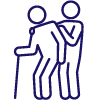- Yokohama-shi Top Page
- Nishi Ward Top Page
- Introduction of the ward
- 80th Anniversary Project
- Do you know? The old days of Nishi Ward
Here's the text.
Do you know? The old days of Nishi Ward
Last Updated February 1, 2025
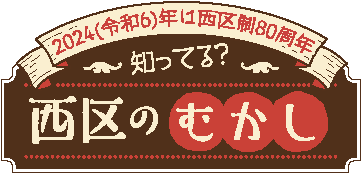
The Nishi Ward Cultural Association's public relations magazine, "Nishibunka," explains the history of Nishi Ward,Nishi Ward.
What is the Nishi Ward Cultural Association?
The Nishi Ward Cultural Association was founded in 1981. It is divided into creative, performing arts, and tea ceremony sections, and anyone can join. "Nishibunka" was published five years after its founding. It is a public relations magazine that tells the story of new knowledge, with culture and history closely related to Nishi Ward and quaint episodes hidden in the region. You can hand it over at Regional Promotion Division (48th window on the 4th floor of the ward office).
The 11th Shugoro Yamamoto (published in the February 2025 issue) ... from Nishibunka No.36
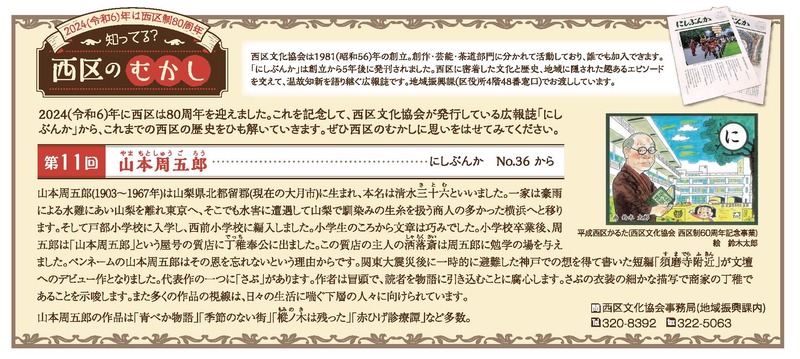
Do you know? The 11th in Nishi Ward
Shugoro Yamamoto (1903-1967) was born in Kitatsuru-gun, Yamanashi Prefecture (now Otsuki City), and his real name was Sato Shimizu. The family left Yamanashi due to the floods caused by heavy rains and moved to Tokyo, where there were many merchants dealing with raw silk that were familiar in Yamanashi after encountering floods. Then I entered Tobe Elementary School and transferred to Nisimae Elementary School. Since I was in elementary school, my writing has been skillful. After graduating from elementary school, Zhou Goro went to a pawn shop called "Shugoro Yamamoto" to serve as a pawn shop. The master of this pawn shop, sai gave Shu Goro a place to study. This is because the pseudonym Shugoro Yamamoto doesn't forget the benefits. A short story "Sumaji Temple )" written in response to the thoughts of Kobe, who was temporarily evacuated after the Great Kanto Earthquake, was his debut work on the literary stage. One of the masterpieces is "Sabu". At the beginning, the author is eager to draw readers into the story. The detailed description of Sabu's costume suggests that it is a merchant's child. In addition, the gaze of many works is directed to the lower people who are struggling in their daily lives.
Shugoro Yamamoto's works include "Aokabe Monogatari", "Seasonless Town", " remains", and "Red Beard Medical Tan".
You can download PDF (PDF: 1,512KB)
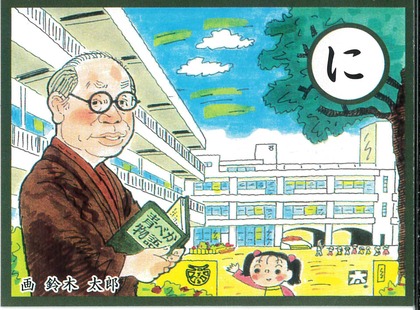
Karuta, Heisei Nishi Ward (60th anniversary commemorative project of the Nishi Ward Cultural Association Nishi Ward system) Picture SUZUKI Taro
The 10th Eiji Yoshikawa (published in the December 2024 issue) ... from Nishibunka No.36
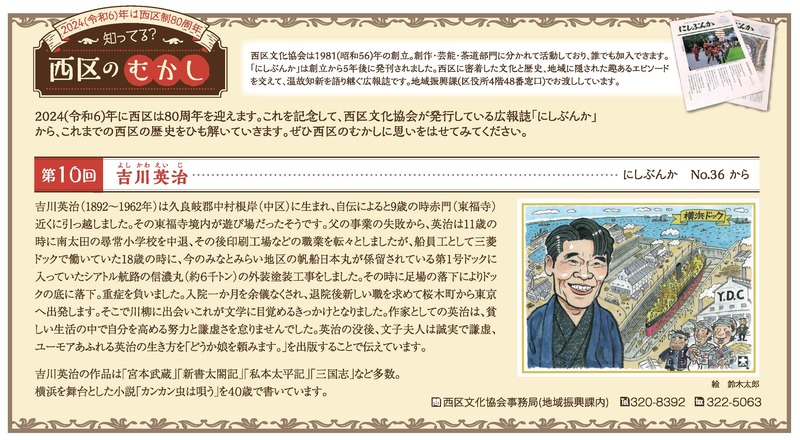
Do you know? The 10th in Nishi Ward
Eiji Yoshikawa (1892-1962) was born in Naka Ward, Nakamura, Kuraki-gun, and according to autobiography, he moved near Akamon (Tofuku-ji Temple) at the age of nine. It seems that the precincts of Tofuku-ji Temple were a playground. Due to the failure of his father's business, Eiji dropped out of Minamiota's ordinary elementary school at the age of 11, and then moved to a printing factory and other occupations, but at the age of 18, when he was working at Mitsubishi Dock as a seafarer, the Sail Training Ship, Nippon Maru in the Minato Mirai district was now moored about Shinsenno on the Seattle route. At that time, it fell to the bottom of the dock due to the fall of the scaffold. I was seriously ill. I was forced to be hospitalized for a month, and after discharge I left Sakuragicho to Tokyo in search of a new job. So I met Kawayanagi and this was the opportunity to wake up to literature. Eiji, as a writer, did not neglect his efforts and humility to enhance himself in a poor life. After the death of Eiji, Mrs. Ayako tells the way of life of Eiji, full of honest, humble, and humor by publishing "Please ask my daughter."
Eiji Yoshikawa's works include "Musashi Miyamoto", "Shinsho Taikoki", "My Hon Taiheiki", and "Mikunishi".
I wrote a novel set in Yokohama, "Kankan Insect sings" at the age of 40.
You can download PDF (PDF: 1,565KB)
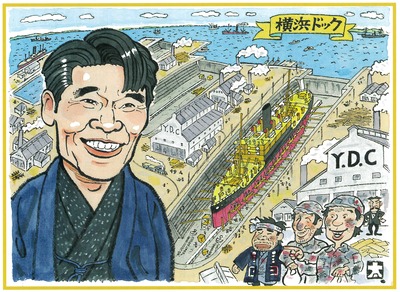
Picture SUZUKI Taro
The 9th Takeo Arishima (October 2024 issue) ... from Nishibunka No.36
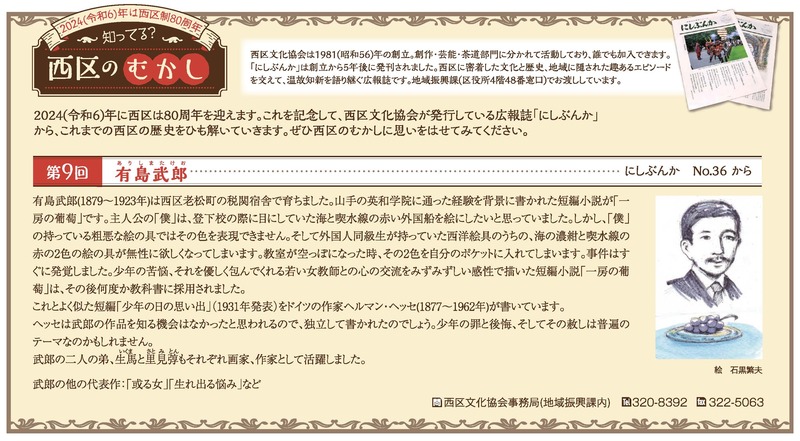
Do you know? The 9th in Nishi Ward
Takeo Arishima (1879-1923) grew up in a customs dormitory in Oimatsu-cho, Nishi-ku. A short novel written based on the experience of attending Eiwa Gakuin in Yamate is "Ichibun Grape". The main character, "I," wanted to draw a picture of a red foreign ship on the sea and the draft line that I saw when going to and from school. However, the poor paint that "I" has cannot express its color. And among the Western paints possessed by foreign classmates, I want to have two colors of paint, dark blue of the sea and red of the draft line. When the classroom is empty, I put the two colors in my pocket. The incident came to light immediately. The short novel "Ichibun no Grape", which depicts the troubles of the boy and the mental exchange with a young female teacher who gently wraps it, with a fresh sensibility, was adopted several times in textbooks thereafter.
German writer Herman Hesse (1877-1962) wrote a short story similar to this, "Memories of Shonen's Day" (announced in 1931).
Hesse seems to have had no opportunity to learn about Takeo's work, so it must have been written independently. The sins and regrets of boys, and their forgiveness, may be a universal theme.
Takeo's two younger brothers, Ikuma and Satomi, respectively, also worked as painters and writers.
Takeo's other representative works: "A certain woman," "Browsiness," etc.
You can download PDF (PDF: 1,558KB)
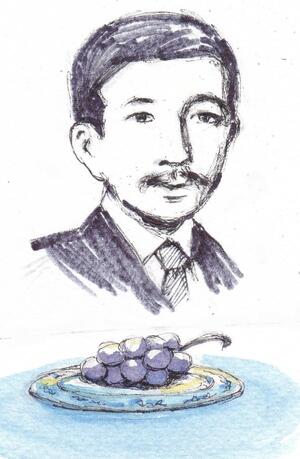
Shigeo Ishiguro
The 8th Kaemon Takashima (published in the August 2024 issue) ... from Nishibunka No.35
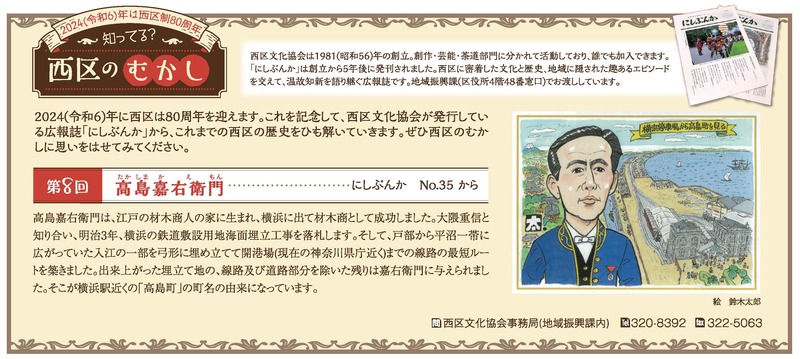
Do you know? The 8th in Nishi Ward
Kaemon Takashima was born in the house of a timber merchant in Edo, and went to Yokohama to succeed as a lumber dealer. I met Shigenobu Okuma, and in 1870, I won a successful bid for the landfill of railway laying land in Yokohama. Then, a part of the inlet that spread from Tobe to the Hiranuma area was reclaimed in a bow shape, and the shortest route of the track to the opening of the port (currently near the Kanagawa Prefectural Office) was built. The rest of the completed landfill, excluding the tracks and roads, was given to Kaemon. This is the origin of the name "Takashimacho" near Yokohama Station.
You can download PDF (PDF: 1,523KB)
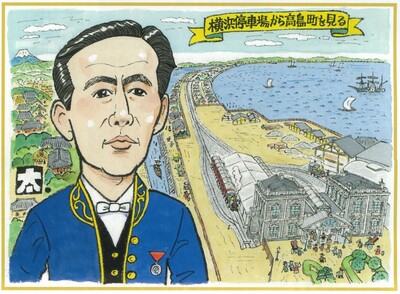
Picture SUZUKI Taro
The 7th Birth of Nishi Ward-Development of Minato Mirai (published in the June 2024 issue) ... from Nishibunka No.28
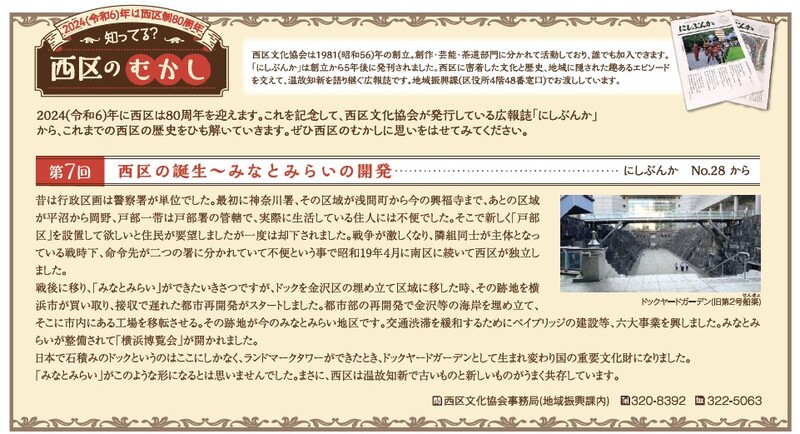
Do you know? The 7th in Nishi Ward
In the past, administrative divisions were in units of police department. First of all, Kanagawa Station, the area from Sengencho to the current Kofuku-ji Temple, the rest area from Hiranuma to Okano, and the Tobe area is under the jurisdiction of Tobe Station, which was inconvenient for residents who actually live . Therefore, residents requested that a new "Tobe Ward" be set up, but they were rejected once. During the war, when the war became intense and the neighboring groups were the main players, Nishi Ward became independent in April 1944, following the Minami Ward, because the commanders were divided into two departments and were inconvenient.
After the war, when the dock was moved to a landfill area in Kanazawa Ward, Yokohama City bought the site and started urban redevelopment, which was delayed due to requisition. Reclaim the coast of Kanazawa and other areas by redevelopment of urban areas, and relocate factories in the city there. The former site is the current Minato Mirai district. In order to alleviate traffic congestion, we have launched six major projects, including the construction of the Bay Bridge. Minato Mirai has been maintained and the Yokohama Exposition has been held.
There is only a masonry dock here in Japan, and when the landmark tower was built, it was reborn as Dockyard Garden and became an important cultural property of the country.
I didn't think "Minato Mirai" would be like this. Indeed, in Nishi Ward, the old and new ones coexist well.
You can download PDF (PDF: 190KB)
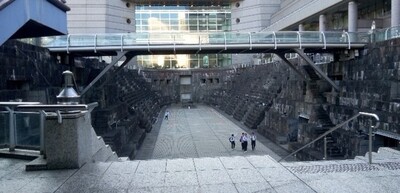
Dockyard Garden (formerly No. 2)
6th Nogeyama Zoo (published in the April 2024 issue) ... from Nishibunka No.34
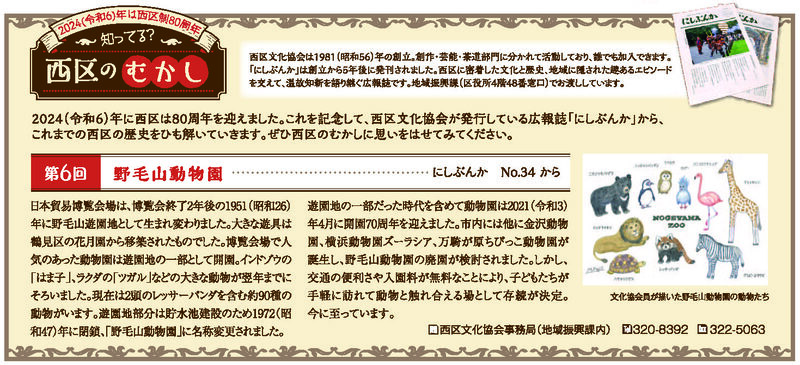
Do you know? The 6th in Nishi Ward
The Japan Trade Expo Center was reborn as Nogeyama Amusement Park in 1951 (Showa 26), two years after the expo. The big playground equipment was relocated from Kagetsuen in Tsurumi Ward. The zoo, which was popular at the exposition venue, opened as part of an amusement park. Large animals such as Indian elephant "Hamako" and camel "Tsugar" were available by the following year. Currently, there are about 90 species of animals, including two red pandas. The amusement park was closed in 1972 to construct a reservoir and renamed Nogeyama Zoo.
The zoo celebrated its 70th anniversary in April 2021 (Reiwa 3), including when it was part of the amusement park. Kanazawa Zoo, Yokohama Zoo ZOORASIA and Makigahara Little Kids Zoo were also born in the city, and the closure of Nogeyama Zoo was considered. However, the convenience of transportation and free admission fees have decided to survive as a place where children can easily visit and interact with animals. It's up to now.
You can download PDF (PDF: 1,482KB)
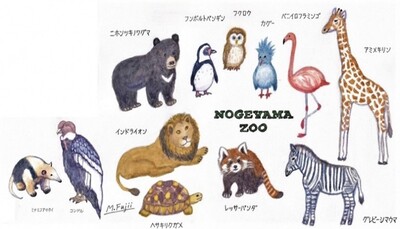
The animals of Nogeyama Zoo drawn by members of the Cultural Association
The 5th Japan Trade Expo (published in the February 2024 issue) ... from Nishibunka No.34
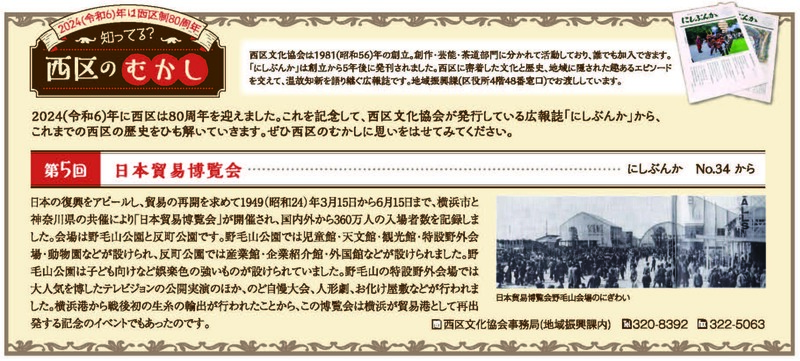
Do you know? The 5th in Nishi Ward
From March 15 to June 15, 1949 (Showa 24), the Japan Trade Expo was held jointly by Yokohama City and Kanagawa Prefecture to promote Japan's revival and seek the resumption of trade, recording 3.6 million visitors from Japan and overseas. The venue is Nogeyama Park and Tammachi Park. In Nogeyama Park, the elementary school student Museum, Tenmonkan, Kankokan, special outdoor venues and zoos were set up, and in Tammachi Park, there were industrial halls, corporate introduction halls and foreign buildings. Nogeyama Park had strong entertainment, such as for children. At the special outdoor venue on Mt. Noge, in addition to a public demonstration of the popular television, a throat boasting tournament, a puppet show, a haunted house, etc. were held. Since the first post-war export of raw silk from Yokohama Port was carried out, this exposition was also a commemorative event for Yokohama to reopen as a trading port.
You can download PDF (PDF: 1,730KB)
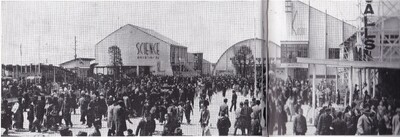
The lively atmosphere of the Nogeyama venue of the Japan Trade Exposition
The 4th statue of Mt. Kamon (published in the December 2023 issue) ... from Nishibunka No.32
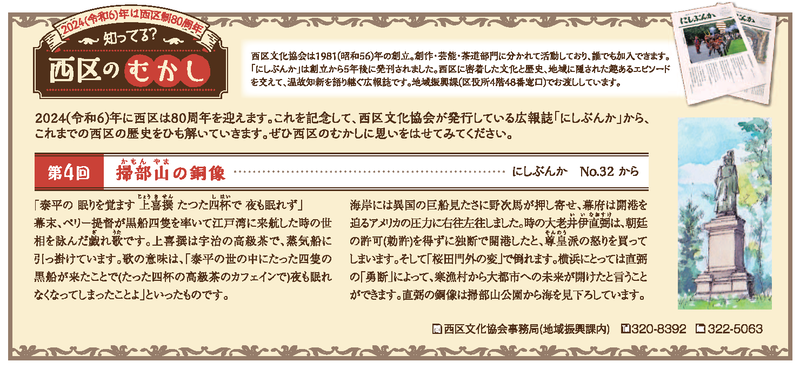
Do you know? The 4th time of Nishi Ward
"I wake up Taihei's sleep, I can't sleep at night with four cups of Kamikisen Tatsuta."
It is a play song that describes the world when Admiral Perry arrived at Edo Bay with four black ships at the end of the Tokugawa period. Kamikisen is a high-class tea from Uji, which is hooked on a steamboat. The meaning of the song is, "The arrival of only four black ships in Taihei's world (with only four cups of high-grade tea caffeine) has made it impossible to sleep at night."
Nojima rushed to the shore as if he saw a huge ship from a foreign country, and the Shogunate turned right and left at the pressure of the United States to open a port. If the elder Naosuke Ii opened the port on his own without the permission of the Imperial Court (edict), it will get the anger of the Emperor. And it falls down with "a strange thing outside Sakuradamon". For Yokohama, it can be said that Naosuke's "Yukari" opened the future from a cold fishing village to a big city. The statue of Naosuke looks down on the sea from Kamonyama Park.
You can download PDF (PDF: 1,727KB)
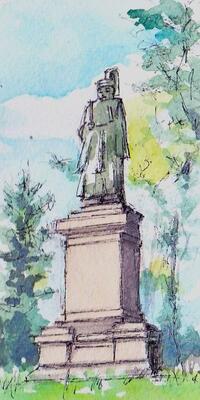
Birth of the 3rd Modern Water Supply (October 2023 issue) ... from Nishibunka No.34
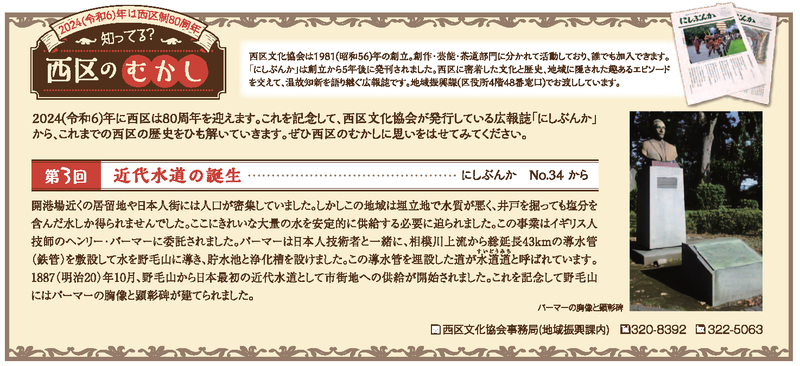
Do you know? The 3rd time in Nishi Ward
The settlements near the opening of the port and the Japanese town were densely populated. However, this area had poor water quality in landfills, and digging wells only salt-containing water. There was a need to provide a stable supply of clean water here. This project was entrusted to the British engineer Henry Palmer. Together with Japanese engineers, Palmer laid a water pipe (iron pipe) with a total length of 43 km from the upper reaches of the Sagami River to guide the water to Mt. Noge and set up a reservoir and a septic tank. The road where this water pipe was buried is called a tap road. In October 1887 (Meiji 20), supply from Mt. Noge to the city as Japan's first modern water supply was started. To commemorate this, a bust of Palmer and a memorial monument were built on Mt. Noge.
You can download PDF (PDF: 1,488KB)
Parker's bust and memorial monument
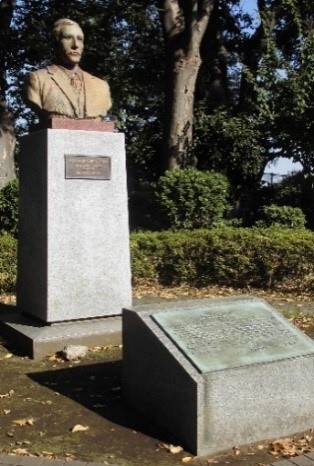
Parker's bust and memorial monument
The 2nd railway between Shimbashi and Yokohama (published in the August 2023 issue) ... from Nishibunka No.35
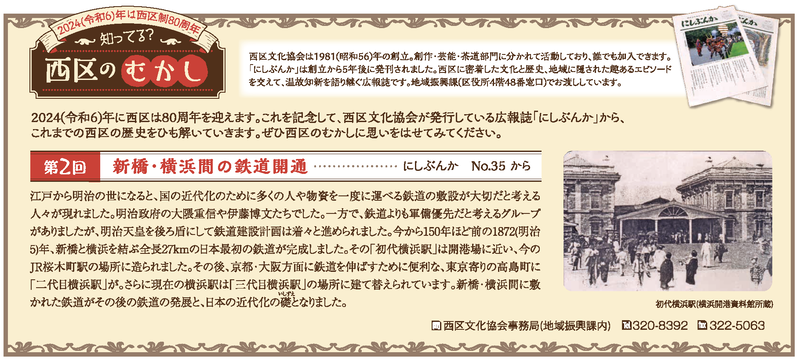
Do you know? The second time in Nishi Ward
From the Edo era to the Meiji era, there were many people who thought it was important to build a railway that could carry many people and goods at once in order to modernize the country. The Yokohama Station, which was built in Yokohama, was built in 2015. On the other hand, the railway construction plan was steadily proceeding with the construction of the Takashimacho Station, which was built in 1JR NEGISHI LINE Sakuragi-cho Sta..
You can download PDF (PDF: 1,862KB)
First Yokohama Station (collected by Yokohama Archives of History)
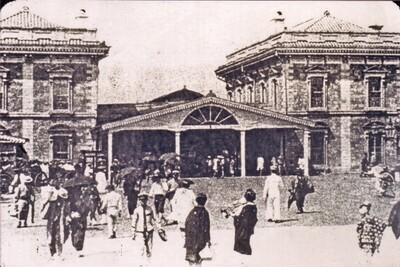
First Yokohama Station
The 1st Encounter with Western Culture (published in the June 2023 issue) ... from Nishibunka No.34
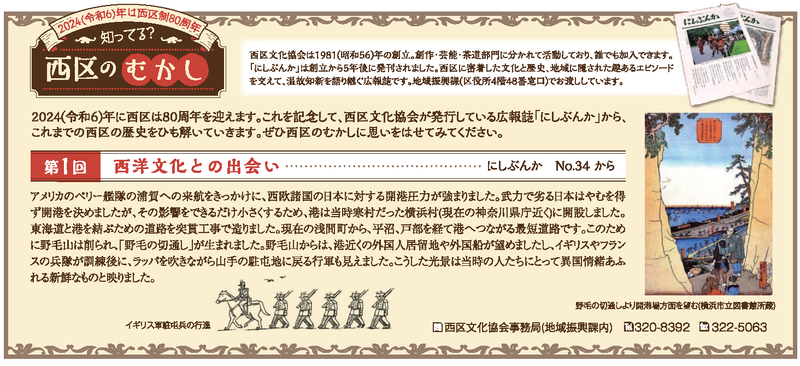
Do you know? The first time in Nishi Ward
In the wake of the arrival of the Perry fleet to Uraga in the United States, the pressure of Western European countries to open ports in Japan was forced to open the port, but in order to minimize its impact, the port was opened in Yokohamamura (near the current Kanagawa Prefectural Office). The shortest route to connect the Tokaido and the port was built by the port.
There was also a march returning to the garrison in Yamate while blowing trumpets, and these scenes seemed to be fresh and exotic to the people of the time.
You can download PDF (PDF: 699KB)
March of British garrison

March of British garrison
View from Noge's exit to open port area (Yokohama City Library Collection)
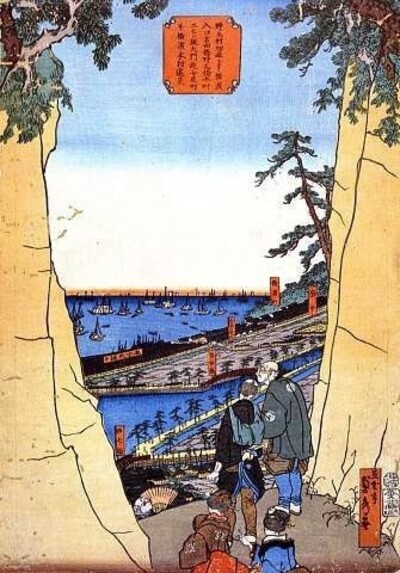
You can see the opening area from Noge's cut-off.
You may need a separate PDF reader to open a PDF file.
If you do not have it, you can download it free of charge from Adobe.
![]() To download Adobe Acrobat Reader DC
To download Adobe Acrobat Reader DC
Inquiries to this page
Executive Committee of the 80th Anniversary of the Nishi Ward System (Secretariat: Ward Administration Promotion Division Nishi Ward)
Telephone: 045-320-8321
Telephone: 045-320-8321
Fax: 045-314-8894
Email address: ni-suishin@city.yokohama.jp
Page ID: 630-274-520








